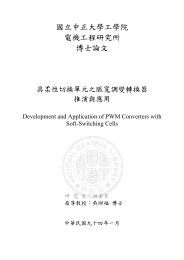Syntax of the Bi Comparative Construction in Mandarin Chinese
Syntax of the Bi Comparative Construction in Mandarin Chinese
Syntax of the Bi Comparative Construction in Mandarin Chinese
You also want an ePaper? Increase the reach of your titles
YUMPU automatically turns print PDFs into web optimized ePapers that Google loves.
<strong>Syntax</strong> <strong>of</strong> <strong>the</strong> <strong>Bi</strong> <strong>Comparative</strong> <strong>Construction</strong> <strong>in</strong> Mandar<strong>in</strong> Ch<strong>in</strong>ese<br />
degree over <strong>the</strong> second one.<br />
(88) a. [wo shuxue kao-de hao] bi [wo y<strong>in</strong>gwen kao-de hao ]<br />
I Math take exam-PART good COM I English take exam-PART good<br />
‘I did better <strong>in</strong> <strong>the</strong> math exam than <strong>in</strong> <strong>the</strong> English one.’<br />
b. [NP wo j<strong>in</strong>tian shufu] bi [wo zuotian shufu]<br />
I today comfortable COM I yesterday comfortable<br />
‘I feel more comfortable than yesterday.’<br />
In Zhang’s (2004) coord<strong>in</strong>ate structure, <strong>the</strong> syntactic structure <strong>of</strong> <strong>the</strong> coord<strong>in</strong>ate<br />
construction is like (89), <strong>in</strong> which <strong>the</strong> external conjunct (<strong>the</strong> first conjunct) is a Spec<br />
<strong>of</strong> <strong>the</strong> coord<strong>in</strong>ator. It may lack evidence and clues to expla<strong>in</strong> <strong>the</strong> reason why <strong>the</strong> ma<strong>in</strong><br />
clause is <strong>the</strong> external conjunct ra<strong>the</strong>r than <strong>the</strong> <strong>in</strong>ternal one.<br />
(89) (Zhang 2004)<br />
&P<br />
qp<br />
(external conjunct) &’<br />
ei<br />
& (<strong>in</strong>ternal conjunct)<br />
(coord<strong>in</strong>ator)<br />
If bi is a coord<strong>in</strong>ator, <strong>the</strong>n sentence (90) has only mean<strong>in</strong>g <strong>of</strong> (90); coord<strong>in</strong>ation<br />
do not have ambiguity. However, accord<strong>in</strong>g to <strong>the</strong> <strong>in</strong>tuition <strong>of</strong> most native speakers,<br />
sentence (90) has both mean<strong>in</strong>gs <strong>of</strong> (i) and (ii).<br />
55<br />
中正大學 e-Thesys (94 學年度)





